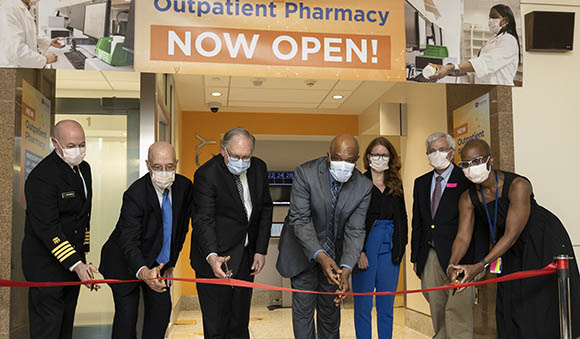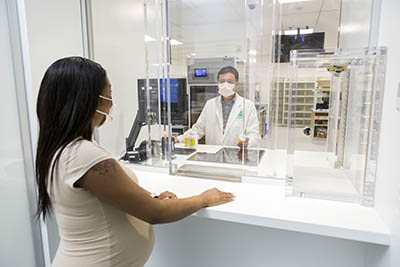Renovated Pharmacy Begins Phased Reopening
Medication Preparation and Dispensing Services Will Be Supported by State-of-the-art Automation

CREDIT: NIH CLINICAL CENTER
On hand for the renovated pharmacy’s May 18 ribbon cutting are (from l) Capt. Richard DeCederfelt, acting pharmacy chief; James Gilman, Clinical Center CEO; Lawrence Tabak, acting NIH director; Alfred Johnson, NIH deputy director for management; Tara Schwetz, NIH acting principal deputy director; Michael Gottesman, NIH deputy director for intramural research; and Marilyn Farinre, pharmacy operations chief.
Who says you can’t go home again? After years of construction and operating out of temporary locations, the Clinical Center’s Pharmacy reopened in a renovated space in the southeast wing on the first floor of the Clinical Research Center within the Building 10 complex.
The 10,000-square-foot facility incorporates the pharmacy’s outpatient, unit-dose, and intravenous admixture unit (IVAU) operations into a single location. The outpatient section opened in early May 2022, followed by the unit-dose section opening in the new space at the end of May and the IVAU coming online this fall.
Acting NIH Director Lawrence Tabak joined Clinical Center CEO James Gilman at a ribbon-cutting event on May 18 for the newly constructed space.
“The NIH invested extensive thought and resources into planning and building a pharmacy that supports our three pillars of patient safety, clinical quality, and world class research,” said Gilman.
The pharmacy’s development was guided by four key principles:
- Safety of patients and staff
- Efficiency to save time, money, and eliminate errors
- Positive staff impact by creating a workplace with high morale, excitement, and engagement
- Regulatory compliance to ensure that the Clinical Center’s Pharmacy meets or exceeds any regulations governing its facility or operations
Cross-departmental teams worked to ensure that the project provided uninterrupted, safe pharmaceutical care for Clinical Center patients. Medication preparation and dispensing services are supported by state-of-the-art automation to protect patient safety and streamline operations.
“Our goal was to move from outdated to outstanding and I think we’ve hit the mark,” said Captain Rick DeCederfelt, acting chief of the pharmacy department.

CREDIT: NIH CLINICAL CENTER
Pharmacy technician Kyfia Clarke acts as a patient receiving medication from pharmacist Hon Lam, at a transaction window of the new pharmacy.
While many things changed behind the scenes, the impact on the patient experience was minimal. Patients meet with a facilitator during the check-in process and continue to check in at a kiosk, and the waiting area in front of the travel office remains the same.
A new outpatient medication pick-up area features three transaction windows with several features to help with patient privacy: frosted glass dividers, acoustic wall coverings, and sound-absorbing ceiling panels.
Behind the scenes, there will be several new procedures that will be invisible to patients but will improve the patient experience and safety. A new system will automate the storage and retrieval of prescriptions, making pick-up faster, more accurate, and more efficient.

CREDIT: NIH CLINICAL CENTER
XR-2, the robotic medication management system that stores and dispenses medications.
At the core of the pharmacy is the XR-2 Automated Central Pharmacy System, a robotic medication management system that stores and dispenses medications. The XR-2 robot weighs more than 20,000 pounds and is so massive it had to arrive in two separate deliveries. Simply unloading the crates of materials from the delivery truck took over four hours.
The pharmacy has 44 cold units to accommodate medications that need to be stored at different temperatures. There are thirty-six refrigerators, six –20° Celsius freezers, and two freezers that can store medication at –80° Celsius.
To support prescription mail services, there is a separate area for packing medication shipments and special secure package doors to support efficient pick-up by mail carriers.
When the IVAU comes online, it will be protected by high-efficiency particulate air filters placed throughout the facility to filter the air supply. Differential pressure, temperature, and humidity will be continuously watched through the pharmacy’s environmental monitoring system and the Clinical Center’s building automation system.
The renovated IVAU follows a single-hood, single-room concept that makes it easier to isolate a compounding area, where customized medications are made, and to continue operations if problems arise.
“We’ve invested in long-term sustainability of the sterile environment and focused on excellence by creating in-house standards exceeding regulations and industry best practices to support and conduct clinical research by providing safe, high-quality care—one patient, and one medication, at a time,” added DeCederfelt.
What do these terms mean?
Outpatient pharmacy: dispenses medications to patients who visit the hospital periodically for check-up or treatment visits as a part of their research protocol.
Unit-dose pharmacy: prepares medications in individual or small size components for patients while they are at the Clinical Center.
Intravenous admixture unit: formulates and packages sterile products on a case-by-case basis to fulfill medical prescriptions for patients while they are at the Clinical Center.
This article was adapted from one that appeared in the May 27, 2022, issue of the NIH Record.
This page was last updated on Thursday, June 30, 2022
